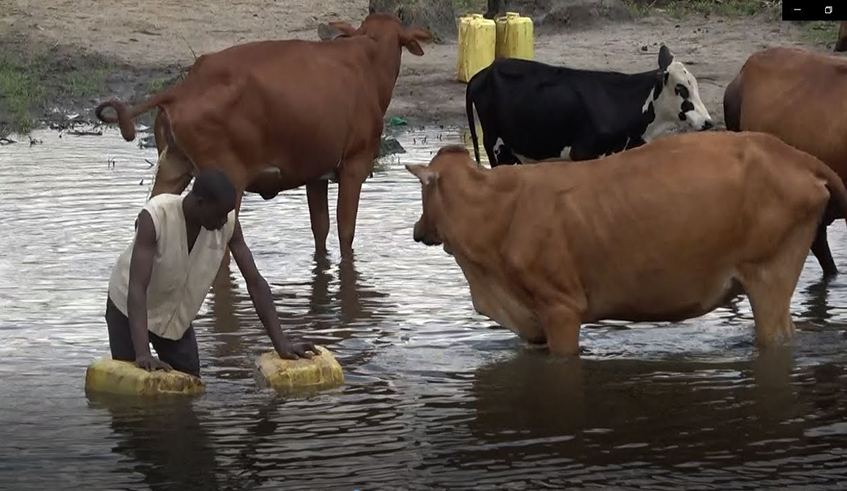

An investigation carried out by a team of researchers namely Christophe Mupenzi, Abias Maniragaba and Gaspard Bayingana found that chemical fertilizers and pesticides, failure to fight against erosion and inefficient management of marshlands in areas surrounding Muvumba River have contributed to pollution of its water and could affects its economic importance.
Muvumba is a river in the Northeastern part of Rwanda and Southwestern Uganda and it is part of the upper headwaters of the Nile River.
At 170 km long, it is one of the major rivers of Rwanda both in size and economic importance.
Its upper course provides water for tea plantations in the high altitudes of North Rwanda and Southwestern Uganda while its lower course provides water for the dry areas of Nyagatare District, facilitating irrigation of rice fields and other crops as well as providing water for cattle farming in this area.
Experts say polluting this river could erode gains and economic importance that are benefited from it.
Dubbed "Potential effect assessment of agricultural activities on water quality of rivers in Rwanda,” the study collected data through interviews, observations, and laboratory tests of raw water from Muvumba River.
The study, whose findings were published in International Journal of Environmental and Agriculture Research (IJOEAR), selected water-sampling points on upstream of Muvumba River with Warufu River as its main tributary flowing from Gicumbi District, and downstream of the river which is dominated by agriculture activities.
"The result presented a positive relationship between agricultural inputs and water quality parameters, therefore, the research hypothesis confirmed that the agricultural activities have contributed to the pollution of water quality of Muvumba River,” reads the study conclusion.
According to studies and farmers, land degradation and soil erosion in Gicumbi District has also played a role in polluting the Muvumba River.
"Without terraces, all fertilizers we would put in soil were always eroded by erosion and deposited into wetlands and Rivers located in Muvumba catchment,” said Anastase Singora, a resident from Murange Sector in Gicumbi District.
During district pollution surveys, fertilizers and pesticides from irrigation schemes in Kaniga sector of Gicumbi district, were cited as major causes of poor water quality in the Cyondo and Muvumba rivers according to another study by the ministry of environment with aim to manage Muvumba River catchment also revealed.
It found that inorganic materials such as silt and sediment and organic materials were above the levels in Warufu and Muvumbers Rivers.
Other sources of pollution include mining activities, industries and others.
Anti-erosion activities to control rainwater, terraces , agroforestry, afforestation, and agricultural activities that do not degrade the soil and the water quality, mixing organic manure with chemical fertilizers as well as creating clubs for environmental protection in order to educate mass population in areas surrounding Muvumba River are among the recommendations
The researchers have suggested better land use on the buffer zone of the marshlands that connect to this River.
This, researchers say, could be done through sensitizing the local community and educating people using croplands surrounding it to respect the law on environment.
"The local community has minimal knowledge about the causes of water pollution,” the study found.
The researchers said it is necessary to teach the population how to manage the agricultural wastes to protect water from pollution.
The district planners, recommendation says, should consider long-term development matters to consider water quality stability while seeking to increase food production.
Some interventions to protect Muvumba from pollution
The 2012 national population and housing census indicated that 725,068 population live in Muvumba catchment.
Catchment means the area from which rainfall flows into a river, lake, or reservoir.
One of the sources of Muvumba catchments is Mulindi River located in Gicumbi district in Northern Province.
From Gicumbi district, there is also Warufu River which flows into the main Muvumba River as the main tributary.
According to Emile Nsengimuremyi, the watershed protection specialist at Rwf33 billion Green project to build climate resilience in Gicumbi district-one of Muvumba River catchment-over 40 tonnes of soil used to be lost annually due to erosion that has also played role in polluting Warufu and Muvumba Rivers.
However, he said terracing activities have reduced soil loss from about 40 tonnes a year to about 15 tonnes thanks to the project.
So far the project in Gicumbi has constructed 1,200 terraces both progressive and bench terraces to fight against erosion while forests have been restored on 747 hectares as a way of protecting and conserving Muvumba catchment.
At least 1,073 of agricultural land were also planted with agroforestry trees while 3,200 out of the targeted 4,000 check dams were constructed for storm water management.
Farmers said that with terraces and other anti-erosion techniques, the harvest has increased.
"Where I used to harvest 80 Kilogrammes of beans, I can now harvest over 120 Kilogrammes on terraced land,” said Singora, a farmer in Mukarange sector.
Why Muvumba River needs protection
The recommended activities to protect the Muvumba River are based on its environmental and economic benefits.
According to the Ministry of Environment there is Rwf 145 billion the project to construct Muvumba multipurpose dam in Nyagatare District to increase the productivity and commercialization of agriculture and livestock products.
The multipurpose dam, to be constructed on 498 hectares according to the feasibility study, intends to construct a dam of 30.5m high with 35 million cubic meter of water.
The residents of Karangazi, Rwimiyaga, Nyagatare, Rukomo, Gatunda, Karama, Tabagwe, Kiyombe, Kabarore, Ngarama, Mimuli Sectors in Nyagatare and Gatsibo Districts will get water for daily domestic uses which is currently serious problem.
An estimated 300,000 people are set to have access to clean water.
With the project, about 8,000 hectares will be irrigated to grow maize, Soya bean, rice, vegetables and fruit trees among others.
The dam is expected to supply water for 16 reservoirs including the eight existing valley dams and eight new ones for livestock and will also produce at least 5,719 megawatt hour (MWh) of hydropower energy annually according to developers.
The project will also protect erosion around the dam by applying terraces, planting trees, agro-forestry trees and other anti-erosion techniques in a developed watershed.
Over Rwf2.4 billion is planned to be spent to implement resettlement action plan including compensation for the properties according to studies.


